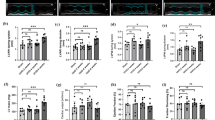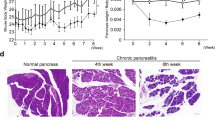Abstract
Skeletal muscle wasting and atrophy is highly prevalent in chronic renal failure (CRF) and increases the risk of mortality. According to our previous study, we speculate that urotensin II (UII) can induce skeletal muscle atrophy by upregulating ubiquitin–proteasome system(UPS) in CRF. C2C12 mouse myoblast cells were differentiated into myotubes, and myotubes were exposed to different concentrations of UII. Myotube diameters, myosin heavy chain(MHC), p-Fxo03A, skeletal muscle-specific E3 ubiquitin ligases such as muscle RING finger 1 (MuRF1) and muscle atrophy F-box (MAFbx/atrogin1) were detected. Three animal models (the sham operation mice as normal control (NC) group, wild-type C57BL/6 mice with 5/6 nephrectomy (WT CRF) group, UII receptor gene knock out (UT KO) mice with 5/6 nephrectomy (UT KO CRF) group) were designed. Cross-sectional area (CSA) of skeletal muscle tissues in three animal models were measured, and western blot detected protein of UII, p-Fxo03A, MAFbx and MuRF1, and immunofluorescence assays explored the satellite cell marker of Myod1 and Pax7, and PCR arrays detected the muscle protein degradation genes, protein synthesis genes and the genes which were involved in muscle components. UII could decrease mouse myotube diameters, and upregulate dephosphorylated Fxo03A protein. MAFbx and MuRF1 were higher in WT CRF group than that in NC group, but after UII receptor gene was knocked out (UT KO CRF), their expressions were downregulated. UII could inhibit the expression of Myod1 but not Pax7 in animal study. We first demonstrate that skeletal muscle atrophy induced by UII associated with upregulating ubiquitin–proteasome system and inhibiting the differentiation of satellite cells in CRF mice.








Similar content being viewed by others
References
Wang XH, Mitch WE (2014) Mechanisms of muscle wasting in chronic kidney disease. Nat Rev Nephrol 10(9):504–516. https://doi.org/10.1038/nrneph.2014.112
Changchien CY, Lin YH, Cheng YC, Chang HH, Peng YS, Chen Y (2019) Indoxyl sulfate induces myotube atrophy by ROS-ERK and JNK-MAFbx cascades. Chem Biol Interact 304:43–51. https://doi.org/10.1016/j.cbi.2019.02.023
Rom O, Reznick AZ (2016) The role of E3 ubiquitin-ligases MuRF-1 and MAFbx in loss of skeletal muscle mass. Free Radic Biol Med 98:218–230. https://doi.org/10.1016/j.freeradbiomed.2015.12.031
Foletta VC, White LJ, Larsen AE, Leger B, Russell AP (2011) The role and regulation of MAFbx/atrogin-1 and MuRF1 in skeletal muscle atrophy. Pflugers Arch 461(3):325–335. https://doi.org/10.1007/s00424-010-0919-9
Ravani P, Tripepi G, Pecchini P, Mallamaci F, Malberti F, Zoccali C (2008) Urotensin II is an inverse predictor of death and fatal cardiovascular events in chronic kidney disease. Kidney Int 73(1):95–101. https://doi.org/10.1038/sj.ki.5002565
Pereira-Castro J, Bras-Silva C, Fontes-Sousa AP (2019) Novel insights into the role of urotensin II in cardiovascular disease. Drug Discov Today 24(11):2170–2180. https://doi.org/10.1016/j.drudis.2019.08.005
Hursitoglu M, Tukek T, Cikrikcioglu MA, Kara O, Kazancioglu R, Ozkan O et al (2012) Urotensin II levels in patients with chronic kidney disease and kidney transplants. Ups J Med Sci 117(1):22–27. https://doi.org/10.3109/03009734.2011.626541
Eyre HJ, Speight T, Glazier JD, Smith DM, Ashton N (2019) Urotensin II in the development and progression of chronic kidney disease following (5/6) nephrectomy in the rat. Exp Physiol 104(3):421–433. https://doi.org/10.1113/EP087366
Abdel-Razik AE, Forty EJ, Balment RJ, Ashton N (2008) Renal haemodynamic and tubular actions of urotensin II in the rat. J Endocrinol 198(3):617–624. https://doi.org/10.1677/JOE-08-0260
Diebold I, Petry A, Burger M, Hess J, Gorlach A (2011) NOX4 mediates activation of Fxo03A and matrix metalloproteinase-2 expression by urotensin-II. Mol Biol Cell 22(22):4424–4434. https://doi.org/10.1091/mbc.E10-12-0971
Liu X, Yu R, Sun L, Garibotto G, Lin X, Wang Y et al (2017) The nuclear phosphatase SCP4 regulates FoxO transcription factors during muscle wasting in chronic kidney disease. Kidney Int 92(2):336–348. https://doi.org/10.1016/j.kint.2017.02.031
Liu L, Hu R, You H, Li J, Liu Y, Li Q et al (2021) Formononetin ameliorates muscle atrophy by regulating myostatin-mediated PI3K/Akt/Fxo03A pathway and satellite cell function in chronic kidney disease. J Cell Mol Med 25(3):1493–1506. https://doi.org/10.1111/jcmm.16238
Pan YJ, Zhou SJ, Feng J, Bai Q, A LT, Zhang AH, (2019) Urotensin II Induces Mice Skeletal Muscle Atrophy Associated with Enhanced Autophagy and Inhibited Irisin Precursor (Fibronectin Type III Domain Containing 5) Expression in Chronic Renal Failure. Kidney Blood Press Res 44(4):479–495. https://doi.org/10.1159/000499880
Joung H, Eom GH, Choe N, Lee HM, Ko JH, Kwon DH et al (2014) Ret finger protein mediates Pax7-induced ubiquitination of MyoD in skeletal muscle atrophy. Cell Signal 26(10):2240–2248. https://doi.org/10.1016/j.cellsig.2014.07.006
Watanabe H, Enoki Y, Maruyama T (2019) Sarcopenia in chronic kidney disease: factors, mechanisms, and therapeutic interventions. Biol Pharm Bull 42(9):1437–1445. https://doi.org/10.1248/bpb.b19-00513
Hong Y, Lee JH, Jeong KW, Choi CS, Jun HS (2019) Amelioration of muscle wasting by glucagon-like peptide-1 receptor agonist in muscle atrophy. J Cachexia Sarcopenia Muscle 10(4):903–918. https://doi.org/10.1002/jcsm.12434
Mak RH, Cheung W, Cone RD, Marks DL (2006) Leptin and inflammation-associated cachexia in chronic kidney disease. Kidney Int 69(5):794–797. https://doi.org/10.1038/sj.ki.5000182
Solagna F, Tezze C, Lindenmeyer MT, Lu S, Wu G, Liu S et al (2021) Pro-cachectic factors link experimental and human chronic kidney disease to skeletal muscle wasting programs. J Clin Invest. https://doi.org/10.1172/JCI135821
Glass DJ (2005) Skeletal muscle hypertrophy and atrophy signaling pathways. Int J Biochem Cell Biol 37(10):1974–1984. https://doi.org/10.1016/j.biocel.2005.04.018
Figeac N, Serralbo O, Marcelle C, Zammit PS (2014) ErbB3 binding protein-1 (Ebp1) controls proliferation and myogenic differentiation of muscle stem cells. Dev Biol 386(1):135–151. https://doi.org/10.1016/j.ydbio.2013.11.017
Rahman MM, Ghosh M, Subramani J, Fong GH, Carlson ME, Shapiro LH (2014) CD13 regulates anchorage and differentiation of the skeletal muscle satellite stem cell population in ischemic injury. Stem Cells 32(6):1564–1577. https://doi.org/10.1002/stem.1610
Olguin HC, Olwin BB (2004) Pax-7 up-regulation inhibits myogenesis and cell cycle progression in satellite cells: a potential mechanism for self-renewal. Dev Biol 275(2):375–388. https://doi.org/10.1016/j.ydbio.2004.08.015
Motohashi N, Asakura A (2014) Muscle satellite cell heterogeneity and self-renewal. Front Cell Dev Biol 2:1. https://doi.org/10.3389/fcell.2014.00001
Lagirand-Cantaloube J, Cornille K, Csibi A, Batonnet-Pichon S, Leibovitch MP, Leibovitch SA (2009) Inhibition of atrogin-1/MAFbx mediated MyoD proteolysis prevents skeletal muscle atrophy in vivo. PLoS ONE 4(3):e4973. https://doi.org/10.1371/journal.pone.0004973
Goncalves MD, Hwang SK, Pauli C, Murphy CJ, Cheng Z, Hopkins BD et al (2018) Fenofibrate prevents skeletal muscle loss in mice with lung cancer. Proc Natl Acad Sci U S A 115(4):E743–E752. https://doi.org/10.1073/pnas.1714703115
Cedernaes J, Schonke M, Westholm JO, Mi J, Chibalin A, Voisin S et al (2018) Acute sleep loss results in tissue-specific alterations in genome-wide DNA methylation state and metabolic fuel utilization in humans. Sci Adv 4(8):r8590. https://doi.org/10.1126/sciadv.aar8590
Li J, Zhao PP, Hao T, Wang D, Wang Y, Zhu YZ, Wu YQ, Zhou CH (2017) Urotensin II inhibitor eases neuropathic pain by suppressing the JNK/NF-kappaB pathway. J Endocrinol 232:165–174. https://doi.org/10.1530/JOE-16-0255
Peris-Moreno D, Taillandier D, Polge C (2020) MuRF1/TRIM63, master regulator of muscle mass. Int J Mol Sci 21(18):6663. https://doi.org/10.3390/ijms21186663
Acknowledgements
This study was supported by Ministry of Education & National Natural Science Foundation of Beijing (Grant No. KZ 202110025038), National Natural Science Foundation of China (Grant No 81570663), the Xuanwu Hospital Huizhi talent leader training program to Aihua zhang
Funding
National Natural Science Foundation of China, Grant No. 81570663, Aihua Zhang,Ministry of Education & National Natural Science Foundation of Beijing, Grant No. KZ 202110025038, Aihua Zhang, Xuanwu Hospital Huizhi talent leader training program
Author information
Authors and Affiliations
Contributions
AZ and YP: designed the study and prepared the first draft of the paper. TZ, XD and LW: contributed to the experimental work. PW and SW: was responsible for statistical analysis of the data. All authors revised the paper critically for intellectual content and approved the final version. All authors agree to be accountable for the work and to ensure that any questions relating to the accuracy and integrity of the paper are investigated and properly resolved.
Corresponding author
Ethics declarations
Disclosures
Yajing Pan, Ting Zhou, Xingtong Dong, Leiyun Wu, Peiwen Wang, Shiyuan Wang and Aihua Zhang declare that they have no conflict of interest.
Human and Animal Rights and Informed Consent
The experimental protocols were approved by the Biological Medical Ethics Committee of the Xuan Wu Hospital, Capital Medical University (AEE-2020–185).
Additional information
Publisher's Note
Springer Nature remains neutral with regard to jurisdictional claims in published maps and institutional affiliations.
Rights and permissions
Springer Nature or its licensor (e.g. a society or other partner) holds exclusive rights to this article under a publishing agreement with the author(s) or other rightsholder(s); author self-archiving of the accepted manuscript version of this article is solely governed by the terms of such publishing agreement and applicable law.
About this article
Cite this article
Pan, Y., Zhou, T., Dong, X. et al. Urotensin II can Induce Skeletal Muscle Atrophy Associated with Upregulating Ubiquitin–Proteasome System and Inhibiting the Differentiation of Satellite Cells in CRF Mice. Calcif Tissue Int 112, 603–612 (2023). https://doi.org/10.1007/s00223-023-01073-4
Received:
Accepted:
Published:
Issue Date:
DOI: https://doi.org/10.1007/s00223-023-01073-4




